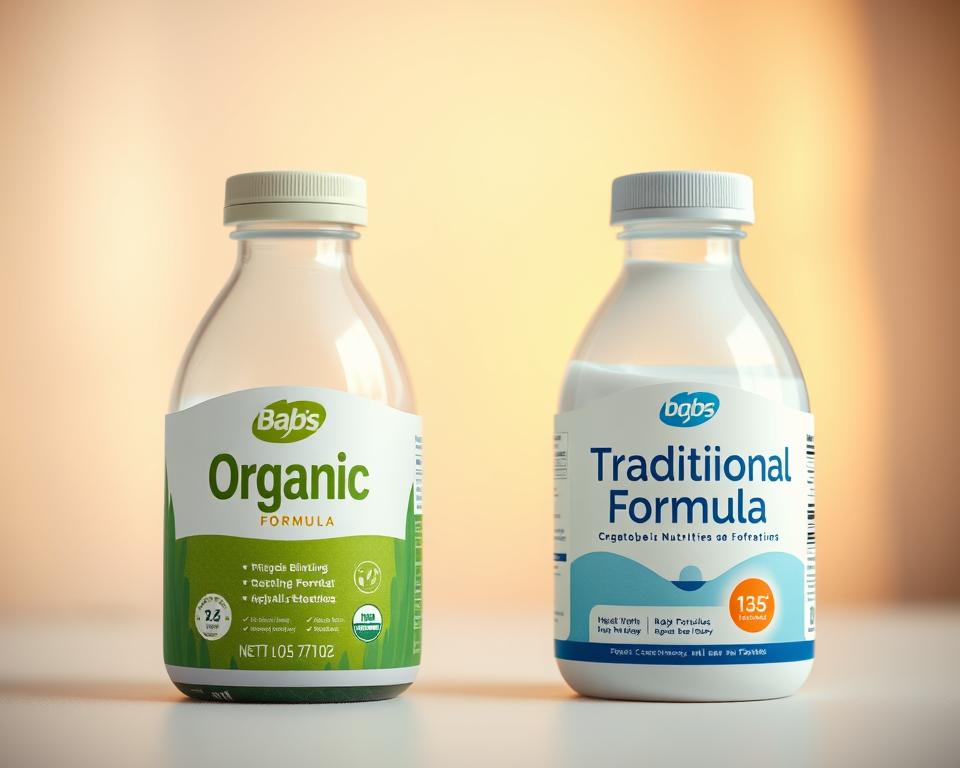Locate the Finest Organic Baby Formulas: A Parent’s Guide
Roughly 80% of U.S. parents turn to formula within baby’s first twelve months. Breastfeeding hurdles often lead to this choice. Choosing the right best newborn formula organic is essential for these families. This guide aims to assist parents in making informed decisions about the best organic formula for their babies.
We will examine various formulas and brands, focusing on quality and nutrition. This information is vital for ensuring a healthy start for your child.
Every caregiver faces the weighty choice of baby’s first foods. Formulas made from certified organic ingredients have surged in demand. It delivers a purer nutrition source. Free from artificial pesticides and fertilizers, they offer infants a purer beginning.
Moms and dads value formulas free from GMOs and synthetic extras. These worries underscore why organic formulas are the preferred safe option.
Perks of Using Organic Elements
Certified organic components deliver notable advantages. These ingredients are rigorously tested, ensuring higher quality and safety. By opting for organic infant formula, parents can rest assured that their child is consuming food free from harmful substances.
Organic farming methods champion eco-friendly and sustainable practices. Hence, selecting organic amplifies wellness and ecological care.
Related Developmental Gains
These formulas may foster healthier developmental results. Many studies suggest that babies receiving organic nutrition may exhibit fewer gastrointestinal issues and a lower likelihood of allergies. This can be attributed to the pure formulation free from synthetic additives.
Parents find comfort in knowing that organic options provide balanced nutrition. Such formulas aid healthy growth and general well-being.

Top Qualities of Organic Infant Formulas
Picking the top organic formula plays a huge role in infant health. Assess protein types alongside key nutritional elements. The type and ratio of proteins can affect how well a baby digests and uses nutrients. Awareness of critical vitamins and fats secures optimal development and health.
Protein Origin and Proportion
Formulas typically blend whey with casein proteins. Whey is easier to digest, while casein provides a slow release of nutrients. More whey generally equals gentler digestion for infants. Many organic options boost whey content for digestive comfort. Look for formulas that clearly list their protein sources and have a balanced ratio for healthy growth.
Vital Additives and Health Boosters
It’s vital to consider the essential nutrients in infant formula for development. DHA and ARA are critical for brain and eye health. Prebiotics also play a role in digestive health and immune system strength. Look out for these components to secure complete nourishment. These organics provide robust nutrient profiles.
| Protein Source | Benefits | Whey-to-Casein Ratio |
|---|---|---|
| Whey | Easier digestibility|Gentle on tummies|Quick absorption | Higher ratio is better|Lean whey blend preferred|Above 60% ideal |
| Casein | Slow release of nutrients|Sustained nourishment|Stomach-friendly over time | Lower ratio preferred in early months|Casein kept minimal|Around 40% or less |
Popular Organic Baby Formula Brands
Caregivers frequently choose reputable names for organic formula. Let’s explore some top choices, highlighting their unique features and standout qualities. Leaders in USDA-certified organics, they meet distinct caregiver expectations.
Kendamil Whole Milk Formula
Kendamil is unique as the only organic baby formula made with whole milk. Enjoy its luscious consistency free from unwanted chemicals. It’s a top pick for parents who value purity in their baby’s diet. You can easily purchase Kendamil with a few clicks.
HiPP’s Combiotik for Delicate Digestions
Designed to soothe, Combiotik suits babies with sensitive guts. It includes prebiotics and probiotics for better digestion. Caregivers rely on HiPP’s quality for peace of mind at organic retailers.
Holle Bio: Trusted European Quality
Holle Bio is renowned for its biodynamic farming practices, providing premium certified organic formula. Renowned for exacting standards and green principles. Parents trust Holle for its authentic taste and nutrition.
Aussie Bubs: The Grass-Fed Option
By sourcing from grass-fed herds, Aussie Bubs maximizes nutrient density. Ingredients mirror a holistic, pasture-based ethos. This distinct sourcing helps caregivers identify premium organics.
Bobbie’s Contemporary Organic Blend
Leading-edge and organic, Bobbie sets new standards. Fulfills today’s nutritional guidelines alongside organic purity. Parents value Bobbie’s nutritional approach as they navigate baby feeding.
Choosing the right organic formula for your baby requires careful thought about their dietary needs. Accounting for sensitivities ensures a comfortable feeding experience. Formula makeup plays a huge role in easing infant digestion.
Identifying Feeding Intolerances
Infants can respond poorly to lactose or intact proteins. It’s vital to seek out products tailored to these needs. Sensitive blends reduce lactose or include pre-broken down proteins. These features aim to reduce irritation and aid in digestive health.
Seek medical advice to confirm the best feeding option.
Prioritizing Gut Ease
A happy belly starts with an appropriate formula choice. These compounds encourage a healthy microbiome and smoother digestion. They help in developing a healthy gut flora, improving digestion and nutrient absorption.
For parents looking for the best organic formula for breastfed babies, many options offer essential nutrients.
How to Transition to Organic Baby Formula
Moving to organics from breast milk or conventional formula works best with steady changes. Grasping best practices eases the process for you and baby. Gradual changes are key to a smooth transition and help your baby accept the organic formula.
Transition Timeline
Begin with small amounts of organics mixed in. Use this plan for the gentlest switch:
- Kick off by blending one part organic with three parts regular formula.
- Each day, shift the ratio more toward organics and away from the old formula.
- If distress appears, reduce the organic increment and proceed more slowly.
- Offer the organic baby formula at controlled times during the day to help your baby associate it positively.
- Keep consistent feeding times to support the changeover.
Positive Transition Signals
As you navigate this transition, recognizing signs of good acceptance will provide reassurance:
- Infant feeds calmly with little to no protest.
- Normal poops and easy digestion continue.
- No significant changes in appetite or feeding patterns.
- Baby smiles and rests peacefully after meals.
Successful organic baby formula acceptance can take time, but these signs indicate a positive adjustment to the new nutrition.
Comparing Organic and Regular Custom Formulas
Many parents are torn between organic baby formula and traditional formula when it comes to their infant’s nutrition. Your choice shapes your infant’s nourishment quality. The focus on ingredient safety and health benefits often guides their choice in this important aspect of parenting.
Ingredient Comparisons
Ingredient lists mark the key divergence between organics and regular formulas. They feature only certified organic elements, omitting artificial chemicals. Names like HiPP, Kendamil partner with organic producers for premium milk. On the other hand, traditional formulas might include synthetic nutrients or non-organic ingredients. It underscores why organics champion pure, unprocessed feeding.
Cost Comparison
Organic formulas generally carry premium pricing because of certification expenses. Certification and sustainable farming drive up the price tag on organics. Despite the higher cost, many parents see the health benefits as worth the investment. Assessing cost versus benefit guides a balanced purchasing decision.
E-commerce platforms now simplify organic formula shopping. Now, they can purchase top-notch formulas from home. Online options cover everything from hypoallergenic to grass-fed blends.
Online Retail Advantages
E-commerce fits into jam-packed daily routines. Shop at home or on the go with no store trips required.
- Ease of access
- Endless formula choices online
- E-tailer discounts often undercut store prices
Subscription Services Explained
Subscription models now dominate formula provisioning. Automated orders keep your formula supply constant.
Subscription plans typically offer these perks:
- Never worry about restocking
- Set delivery intervals to match your consumption rate
- Cost Savings: Many subscription services offer discounts compared to one-time purchases
Compliance Requirements for Organic Formulas
Guaranteeing formula purity demands robust regulation. It involves a detailed framework of regulatory standards. FDA mandates safeguard formula nutrient profiles and hygiene. Organic labels backed by USDA verify farm-to-formula purity. Understanding these standards empowers parents to make informed choices for their infants.
FDA Oversight and Standards
U.S. FDA controls critical aspects of formula manufacturing. Their strict guidelines cover nutrient requirements and permissible ingredients. Such rules guarantee balanced nourishment for infants. Main elements are:
- Mandatory ingredient listings|Required ingredient disclosures|Compulsory component labeling
- Specific nutrient requirements such as protein, fats, and vitamins|Defined macro- and micronutrient thresholds|Preset nutrition minimums
- Comprehensive quality control measures during manufacturing|Rigorous production inspections|Stringent safety checks
Adherence to these FDA regulations guarantees that only safe, nutritionally adequate products are available.
USDA Organic Certification Guidelines
USDA organics seals mark trusted formula authenticity. It includes multiple verification steps to ensure compliance. Major requirements are:
- Proof that ingredients are produced without synthetic fertilizers or pesticides|No chemical fertilizers or sprays used|Farm inputs must be 100% natural
- Verification of non-GMO (genetically modified organism) status|Guarantee of GMO-free sourcing|Strict non-GMO testing
- Clear guidelines on the handling and processing of organic products|Protected organic integrity during production|Certified organic processing rules
USDA-approved organics guarantee farm-level purity. These standards deliver safer, nutrient-rich formulas. Together, these frameworks give caregivers full assurance.
| Regulatory Aspect | Description |
|---|---|
| FDA Regulations | Sets safety and nutrient standards for infant formula |
| USDA Organic Certification | Ensures organic ingredients are grown without harmful substances |
| Quality Control | Mandatory checks during production processes |
| Ingredient Transparency | Clear labeling of all components for consumer knowledge |
How to Purchase Organic Infant Formula
Selecting the optimal organic formula might feel overwhelming. But with key tips, parents can confidently select the best option. Being aware of sources and certifications eases the purchase.
Best E-Tailers for Organic Formula
Numerous reputable e-retailers stock certified organics. These sites frequently run promotions. Consider these popular options:
- Amazon – Known for its wide variety and fast shipping
- Target – Offers convenient delivery options and in-store pickup
- Walmart – Combines web ordering and brick-and-mortar access
- Thrive Market – Specializes in natural and organic groceries
Check user feedback and ratings first. Use reviews to judge formula performance and vendor service.
Understanding Labeling and Certifications
Knowing label terminology ensures you get true organics. Seek official seals verifying organic compliance. Common ones include:
| Certification | Description |
|---|---|
| USDA Organic | Indicates the formula contains at least 95% organic ingredients |
| Non-GMO Project Verified | Means the formula does not use genetically modified organisms |
| European Union Organic | Denotes adherence to EU organic farming regulations |
Identifying labels confirms both safety and quality.
As a Final Point
In summary, the right organic choice shapes infant wellness significantly. Organic baby food offers more than just ingredients; it ensures your child’s overall well being. You get essential vitamins and minerals minus toxins. Caregivers now know to check protein ratios, sensitivity profiles, and top names like Kendamil and Holle.
Our guide underscored customizing choices to your baby’s health. Transitioning to organic options should be a careful process. Slow steps keep baby happy and well.
Guided by these pointers, you’ll choose with confidence from many choices. Opting for organic feeding fosters lifelong nutritional good habits. Remain committed to offering the best start in life. We should support them with the best possible choices as they begin their food journey.


